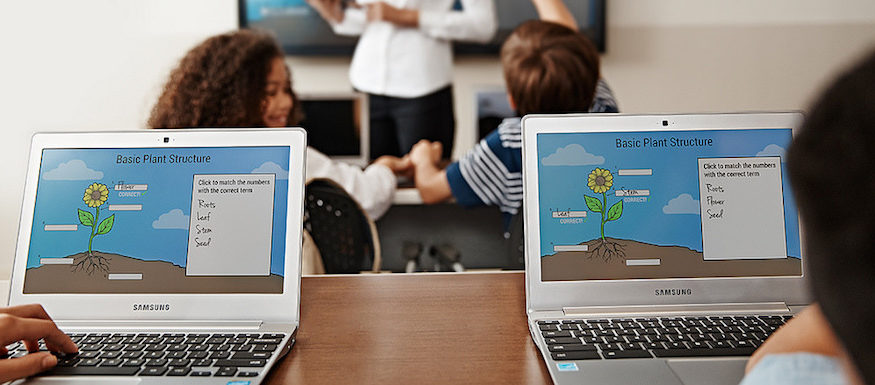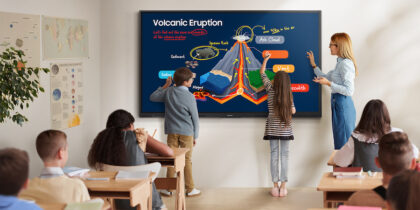This News Insight from Samsung Networks examines the potential of Wi-Fi and classroom technology to revolutionize differentiated learning. Discover how interactive displays are engaging students and opening up new learning possibilities. —Samsung Insights editorial team
Differentiated learning is not a passing fad. Those who understand the true intent behind the practice recognize that it’s not about individualized lesson plans or customized classrooms. It’s about meeting students where they are and helping them arrive where they need to be… in different ways. Simplistically speaking, it’s about pacing, accommodations, and learning modalities.
But you already know that.
What you may not fully comprehend is how technology plays a role in differentiated instruction, expanding the possibilities and making it more manageable for teachers at the same time.
The Technological Tools of Digital Differentiation
Since its inception, differentiation has looked a lot like learning stations and group projects. Accommodations have looked like highlighted/marked-out, custom handouts and special seating. Twenty-first century learning environments need to adapt.
Smart boards are outstanding tools for student engagement and collaboration… provided each student has a way to actively engage with the board in real time. But true differentiation requires multiple devices. It requires students to have consistent access to tablets or Chromebooks. In some schools this only happens because it’s a BYOD (bring your own device) classroom. In others, successful 1:1 initiatives have placed devices in the hands of each and every student, setting up an environment that’s optimally conducive to differentiation.
It’s all dependent on one other thing, though, something most people take for granted until it stops working properly.
Connecting It All (Administrators, Take Note!)
In the most ideal school, with the most current devices and the most savvy teachers, digital learning will still be inhibited by one thing: an unreliable Wi-Fi network. Think of it this way: if you were building a new house and found the most up-to-date kitchen sink, the most advanced sprinkler system, and the most beautiful shower heads, you will have wasted your time and money if you failed to consider the plumbing that connects these items to the water municipality.
In the same way, a digital learning environment is only as effective as the network infrastructure it’s built upon.
How to Fund Your Classroom Technology
Download this guide to plan, purchase and deploy new technology tools while addressing funding gaps. Download Now
Teachers will struggle to use devices for differentiation in the classroom when they are forced to troubleshoot student connectivity issues. At some point they will give up on the devices and revert to old methodologies. Objectives must be met and assessments given, whether or not the Wi-Fi is functional. As a result, differentiation potential is hindered when a network is:
- Outdated or piecemealed
- Unreliable because of the physical limitations of the building or the quality of the network
- Not equipped for the number of devices using it
- Difficult for network managers to troubleshoot
That’s the dystopian view of the matter. Let’s turn, now, to look at what’s possible with the right Wi-Fi network.
How Differentiated Instruction Might Look with a Better Wi-Fi Network Infrastructure
Imagine, if you will, a classroom with a digital infrastructure that allowed each student to have a tablet or Chromebook of their own and a teacher who was passionate about using the technology to enhance differentiated instruction.
- There could be differentiation in readiness levels without student embarrassment, because the pacing was privatized and remained secure on the student’s device.
- There could be differentiation based on IEPs without drawing undesired attention to learning differences in the classroom, because the accommodations were also private within the device.
- There could be differentiation based on interests, because Internet access offers virtually limitless resources.
- There could be differentiation based on learning modalities, because students could create and examine topics in new ways.
- There could be differentiation in how the content is presented (with or without a flipped classroom) because videos, podcasts, articles, demonstrations, and webinars can all be accessed (or created by teachers) online.
- There could be differentiation in the process students go through to familiarize themselves with the content: guided experiments, rote practice, interactive Q&A, online discussion forums, research findings, educational games, etc.
- There could be differentiation in the product students present at the end of a unit: a website they created, a video they directed, a presentation they created, a blog post they wrote, or an online assessment they completed… just to name a few.
All of the differentiation is made possible by a Wi-Fi network capable of bearing the burden of a high-density environment like a school, where students, administrators, faculty, and the building itself rely on connectivity to function optimally.
The Technological Responsibility of School Administrators
The International Society for Technology in Education (ISTE) has released standards for students, educators, and administrators to help lead each part of the education community through the “complexities of the digital age”. Two of the related standards for administrators follow:
- Provide learner-centered environments equipped with technology and learning resources to meet the individual, diverse needs of all learners. (2b)
- Establish and maintain a robust infrastructure for technology including integrated, interoperable technology systems to support management, operations, teaching, and learning. (4e)
What actions will you take to live up to those standards?
You know the benefits of differentiated instruction. Now you see the value of a Wi-Fi network infrastructure to a differentiated digital learning environment.
Samsung is uniquely positioned to not only offer great devices, but to provide the network that connects those devices, both now and in the future. Build a network that will scale with future changes while expanding differentiation possibilities today. Be a leading 21st century educator.
To talk to a Samsung Wi-Fi expert about how to upgrade the network in your school and what sets Samsung apart from other networks, schedule a FREE consultation. You’ve got nothing to lose and world of possibilities to gain.
Explore Samsung’s full line of learning solutions tailored for classrooms of all ages and learning abilities.









